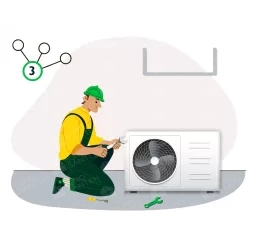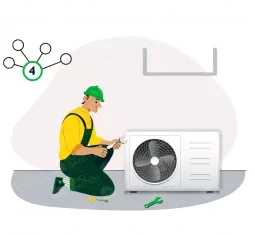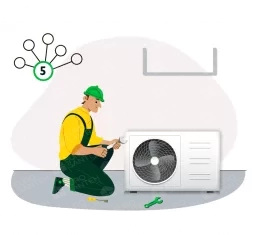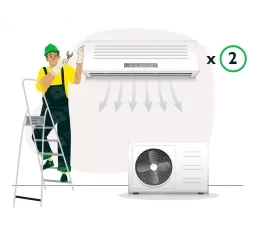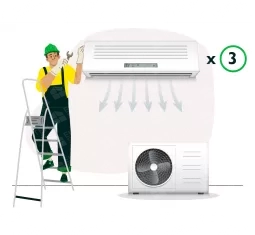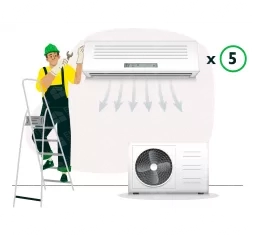Installation of multi split system in Chisinau
Installing a multi split system is a complex process that involves meticulous planning, precise execution, and adherence to manufacturer guidelines. Multi split systems are designed to provide efficient air conditioning and heating solutions for multiple rooms or zones using a single outdoor unit and multiple indoor units. In this detailed guide, we will explore the essential steps, considerations, and best practices involved in the installation of a multi split system to ensure optimal performance and longevity.
Pre-Installation Preparation
Before commencing the installation process, thorough preparation is essential to ensure smooth execution and to minimize potential issues:
Site Assessment: Evaluate and plan the installation locations for each indoor unit and the outdoor unit, considering factors such as room size, layout, structural integrity of walls, and proximity to electrical sources.
Electrical Readiness: Ensure adequate electrical supply and capacity to support the power requirements of all indoor and outdoor units. Verify compliance with local electrical codes and safety standards.
Piping and Routing Planning: Plan the refrigerant piping routes from the outdoor unit to each indoor unit, considering optimal distance, elevation changes, and insulation requirements to minimize energy loss and ensure efficient operation.
Steps for Installing a Multi Split System
1. Installation of the Outdoor Unit
Location Selection: Choose an appropriate outdoor location that allows for proper airflow, noise reduction, and easy access for maintenance. Ensure the surface is level and stable to support the weight of the unit.
Mounting and Fixation: Install the outdoor unit on a concrete pad or mounting brackets, ensuring it is securely fixed to prevent vibrations and noise during operation.
Refrigerant Piping: Connect the refrigerant lines from the outdoor unit to each indoor unit, ensuring proper sizing, sealing, and insulation to maintain efficiency and prevent refrigerant leaks.
2. Installation of Indoor Units
Positioning: Determine the optimal placement of each indoor unit within the designated rooms or zones to ensure even air distribution and effective cooling or heating.
Mounting: Securely mount each indoor unit on the wall or ceiling using appropriate brackets or supports, ensuring stability and proper alignment for optimal airflow.
Electrical Connection: Connect the indoor units to the power supply, following electrical diagrams provided by the manufacturer. Ensure all connections are secure and insulated to prevent electrical hazards.
3. Piping and Drainage
Condensate Drainage: Install and route condensate drainage pipes from each indoor unit to appropriate drainage points, ensuring proper slope and clear pathways to prevent water buildup and damage.
Refrigerant Piping Insulation: Insulate refrigerant pipes thoroughly to minimize heat exchange and maintain consistent cooling and heating performance across all indoor units.
4. Electrical Wiring and Control Setup
Wiring Connections: Connect control wiring between the outdoor unit and each indoor unit to facilitate communication and control functions such as temperature settings and fan speed.
Testing and Commissioning: Perform comprehensive testing of the entire system to ensure all indoor units are functioning correctly, and there are no refrigerant leaks or electrical faults. Adjust settings as necessary for optimal performance.
5. Completion and Aesthetic Considerations
- Finishing Touches: Conceal wiring and pipes where possible to enhance the aesthetics of the installation. Ensure all components are neatly arranged and secured for a professional appearance.
Maintenance and Ongoing Care
To maintain the efficiency and longevity of your multi split system, regular maintenance is essential:
Filter Cleaning: Clean or replace air filters regularly to maintain indoor air quality and prevent airflow restrictions.
Annual Service: Schedule annual maintenance checks with qualified technicians to inspect refrigerant levels, check for leaks, and ensure all components are operating within optimal parameters.
Conclusion
The installation of a multi split system requires careful planning, technical expertise, and adherence to safety standards to ensure effective operation and energy efficiency. By following the steps outlined in this guide and investing in professional installation and maintenance, homeowners and businesses can enjoy reliable climate control across multiple zones or rooms. Proper installation and ongoing maintenance not only optimize performance but also extend the lifespan of the system, making it a worthwhile investment in indoor comfort and energy savings.

